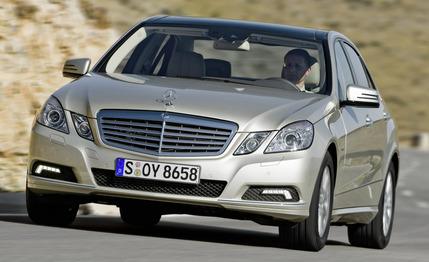
 Second Drive
Second Drive
The German penchant for silly eyewear has expressed itself in the headlights of Mercedes-Benzes for a while now, and the 2010 E-class continues this proud tradition. Gone are the ovoid frames of the last E-class, in favor of a hipper set of squared-off lenses. The rest of the E-class is similarly predictable—it’s still an upright sedan, its dimensions are within fractions of an inch of the previous generation’s, and the same engines as last year power it.
The angular theme starts at the headlights and spreads rearward to form a chiseled yet still conservative body. The only peculiar and controversial aspect of the design is the upside-down swoosh that runs over the rear fenders. Mercedes tells us that the rear fenders are supposed to recall the ’50s Ponton models; we think Nike’s lawyers might want to take a look. The fenders do look better in person if wheels 17 inches or larger are selected, sizes that will be standard on U.S.-bound E-classes.
Underneath is an all-new unibody structure that Mercedes claims is 30 percent stiffer and able to meet future crash requirements. The beefier structure leads to a weight increase of 150 pounds in the E350 and 260 pounds in the E550, according to the company. Predictably, acceleration from the 268-hp, 3.5-liter V-6 E350 and the 382-hp, 5.5-liter V-8 E550 suffers—zero-to-60 times will likely be slower by a few 10ths compared with last year’s results. In the fall, the 507-hp E63 AMG joins the lineup. A 50-state-legal diesel E320 Bluetec will be added early next year. All engines will be equipped with a seven-speed automatic.
The interior is a pleasing mix of high-budget S-class materials and a few entry-level C-class–like buttons. Shifting is now done via a column-mounted stalk, as in the S-class. Plastics, leather, and wood blend harmoniously, and new, more thickly padded seats improve comfort substantially.
The big change in the driving experience is a shift away from the somewhat sluggish and slightly disconnected steering to a more connected and responsive rack—not to the level of BMW tactility but a move upward. Similarly, the E550 we drove had a retuned Airmatic suspension that was more agile than we can recall in previous E-classes. At freeway speeds, wind and road noise is hushed, and the Benz does a convincing Lexus impersonation but with a ride that is even more composed.
Until the revised S-class arrives this fall, the E-class will be Mercedes’ poster boy for safety. But a lot of the E’s safety gear is optional, such as blind-spot detection, lane-departure warning, automatic emergency braking, Adaptive High Beam Assist (which automatically varies the headlight angle and intensity depending on traffic conditions), and Night View Assist with pedestrian detection. Standard safety equipment includes 11 airbags and Attention Assist, which monitors driver behavior and sounds a warning and flashes a light on the dash in response to signs of drowsiness.
Without the E-class, the Mercedes-Benz showroom would have no center—just the entry-luxe C-class, the lavish S-class, a mix of SUVs, and the thunderous AMG models. Priced from about $57,000 and rising above $90,000 for the upcoming AMG model, the E-class’s role is to bridge the gap. The best part of this new, more luxurious E is that it leans more toward the S-class side of the family, ultrahip eyewear and all.